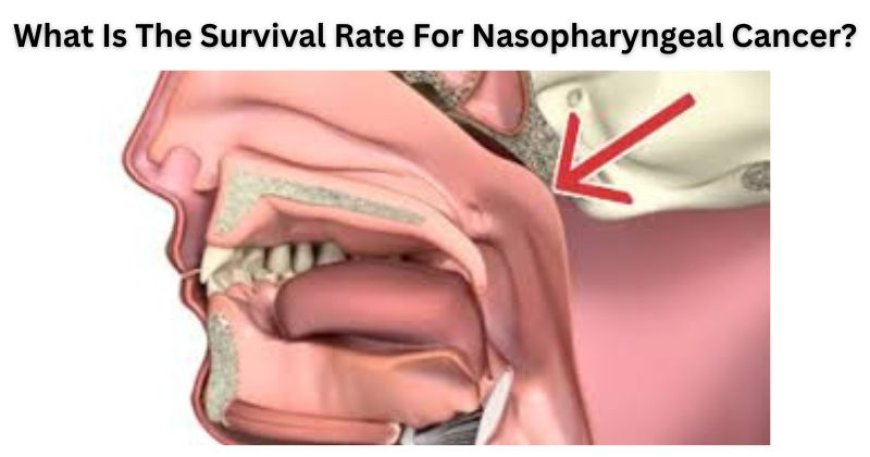What Is The Survival Rate For Nasopharyngeal Cancer?
The survival rate for nasopharyngeal cancer depends heavily on the stage at diagnosis, with earlier stages offering more favorable outcomes. For patients diagnosed with nasopharyngeal cancer, treatment options have improved considerably over the years, and many patients can live long, healthy lives after treatment, especially if the cancer is caught early.

Nasopharyngeal cancer (NPC) is a type of cancer that originates in the nasopharynx—the upper part of the throat, behind the nose. While relatively rare in many parts of the world, nasopharyngeal cancer is more common in certain regions, such as Southeast Asia, particularly in Hong Kong, Southern China, and Taiwan. Like many cancers, the nasopharyngeal cancer survival rate can vary depending on various factors, including the stage of the disease, the patient’s overall health, and how well the cancer responds to treatment.
What Is Nasopharyngeal Cancer?
Nasopharyngeal cancer is a malignancy that develops in the cells of the nasopharynx, which is located just behind the nose and above the back of the throat. This area plays a crucial role in both respiration and digestion. NPC can spread locally to nearby tissues or to distant parts of the body, including the lymph nodes, lungs, or liver.
NPC is usually diagnosed through imaging tests, biopsies, and other diagnostic tools. Symptoms can include a lump in the neck (often from swollen lymph nodes), frequent nosebleeds, difficulty breathing, ear infections, hearing loss, and nasal congestion. Because these symptoms are similar to those of other conditions, NPC can often go undiagnosed until it has advanced.
Nasopharyngeal Cancer Survival Rate
The nasopharyngeal cancer survival rate is typically expressed in terms of the 5-year relative survival rate. This refers to the percentage of people who live at least five years after their diagnosis of NPC, compared to individuals in the general population. It's important to remember that survival rates are averages, and individual outcomes can vary significantly.
Overall, the 5-year relative survival rate for nasopharyngeal cancer tends to be quite favorable in early stages, but it declines as the disease progresses. According to the American Cancer Society, the 5-year survival rate for nasopharyngeal cancer in the United States is approximately 60-70%. However, this rate can vary significantly depending on the stage at which the cancer is diagnosed.
Stage 1 Nasopharyngeal Cancer Survival Rate
At stage 1, nasopharyngeal cancer is localized to the nasopharynx and has not spread to nearby lymph nodes or other organs. Early-stage NPC is highly treatable, and patients diagnosed at this stage have a much better chance of surviving. The 5-year survival rate for stage 1 nasopharyngeal cancer is typically higher, often exceeding 80-90%.
Treatment at this stage usually involves radiation therapy, which is very effective at targeting the tumor without the need for surgery. In some cases, chemotherapy may also be used as an adjunct treatment. With early detection and appropriate therapy, patients diagnosed at stage 1 can expect a good quality of life post-treatment.
Stage 2 Nasopharyngeal Cancer Survival Rate
Stage 2 NPC indicates that the cancer has spread to nearby tissues or lymph nodes but remains confined to the head and neck region. The 5-year survival rate for stage 2 nasopharyngeal cancer is typically around 60-75%, although treatment outcomes can vary. Radiation therapy remains the primary form of treatment, sometimes combined with chemotherapy.
Stage 2 patients may experience a higher likelihood of recovery, particularly if the cancer is localized and hasn’t spread further. Treatment plans are highly personalized based on the extent of the spread, and patients may undergo regular follow-up tests to monitor for recurrence.
Stage 3 Nasopharyngeal Cancer Survival Rate
At stage 3, nasopharyngeal cancer has spread to nearby lymph nodes or tissues but has not yet reached distant organs. The 5-year survival rate for stage 3 NPC drops somewhat compared to earlier stages, usually ranging between 50-60%. This is due to the more extensive spread of cancer, which can make treatment more challenging.
Treatment for stage 3 nasopharyngeal cancer often involves a combination of radiation therapy, chemotherapy, and sometimes surgery, depending on the location and size of the tumor. While the prognosis for stage 3 patients can still be good, the chance of recurrence is higher than in earlier stages.
Stage 4 Nasopharyngeal Cancer Survival Rate
Stage 4 nasopharyngeal cancer is the most advanced stage, where the cancer has spread to distant organs such as the liver, lungs, or bones. The 5-year survival rate for stage 4 nasopharyngeal cancer is significantly lower, typically around 30-50%. Treatment options may include chemotherapy, radiation, and sometimes immunotherapy, but the chances of a cure are considerably reduced.
Stage 4 NPC often requires aggressive treatment strategies, and patients may experience a greater range of side effects due to the combination of treatments used. While survival rates are lower for advanced-stage NPC, it is important to remember that ongoing research, new therapies, and clinical trials continue to improve the outlook for many patients.
Factors Affecting Nasopharyngeal Cancer Survival Rate
While the stage of nasopharyngeal cancer is one of the most significant factors influencing survival, several other variables can also play a role:
-
Age and Overall Health: Younger patients and those with fewer underlying health conditions tend to have a better prognosis. Older patients or those with comorbidities may face additional challenges.
-
Response to Treatment: NPC is generally responsive to radiation and chemotherapy, but individual responses can vary. Some patients may achieve complete remission, while others may experience recurrence or treatment resistance.
-
Location and Size of the Tumor: Tumors located in certain areas of the nasopharynx, or those that are larger, may be harder to treat and may require more aggressive therapy.
-
Genetic and Molecular Factors: Research into the genetic and molecular characteristics of nasopharyngeal cancer is ongoing. These factors can help doctors predict how the cancer will behave and whether newer, targeted therapies might be effective.
-
Access to Care: Access to early diagnosis, specialized treatments, and advanced healthcare systems can also significantly impact survival outcomes.
Conclusion
The survival rate for nasopharyngeal cancer depends heavily on the stage at diagnosis, with earlier stages offering more favorable outcomes. For patients diagnosed with nasopharyngeal cancer, treatment options have improved considerably over the years, and many patients can live long, healthy lives after treatment, especially if the cancer is caught early. However, for those with stage 4 nasopharyngeal cancer, the prognosis is more challenging, and survival rates tend to be lower. It’s important to remember that survival statistics are only averages, and many factors can influence individual outcomes.
If you or a loved one has been diagnosed with nasopharyngeal cancer, it’s crucial to work closely with a healthcare provider to understand the specific treatment options and prognosis. As research continues to advance, there is hope for improved survival rates and better quality of life for NPC patients in the future.
What's Your Reaction?


























